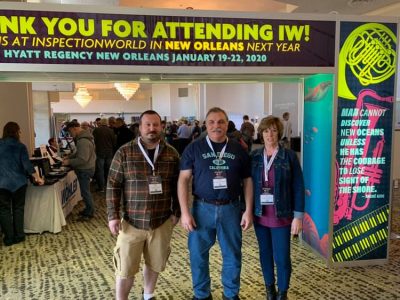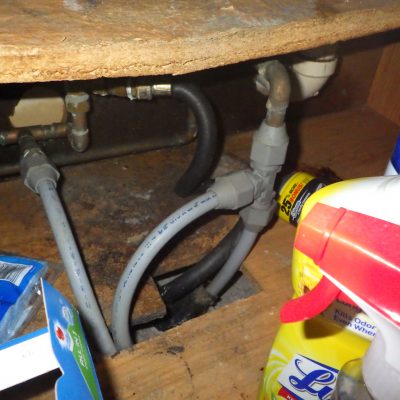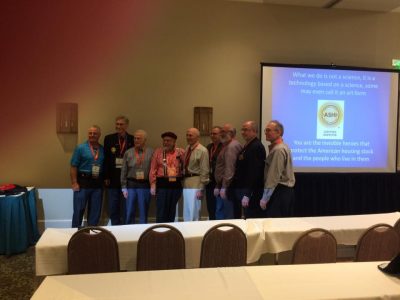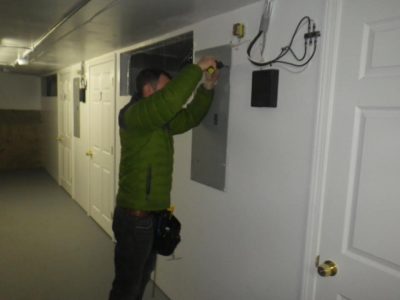AJ, Steve and Sue were at ASHI World San Diego in Jan 2019. Keeping up with the latest in Home Inspections. World class education, taught by best minds in the business. 

AJ, Steve and Sue were at ASHI World San Diego in Jan 2019. Keeping up with the latest in Home Inspections. World class education, taught by best minds in the business. 

You are the Home Inspector, what is the overall concern here?
I got to meet the founding fathers of ASHI while in Orlando at ASHI’s Inspection World. It was a meet and greet before classes started on Monday morning. Truly an incredible experience. Wonderful gentlemen who got the ball rolling for all of us home inspectors back in the 60-70,s. They have my total respect.
We were treated to the presentation of “Early Days of ASHI” Three of ASHI’s original members, Ron Passaro (ASHI member #1), John Heyn (#5), and Norman Becker P.E. (#7) took us back to the time when a “society for home inspectors” was just an idea. We heard terrific stories of how ASHI was created. Learned about the dedicated people who created the ASHI SOP and Code of Ethics. This was a can’t miss for me.
One gentleman had his original cardstock flyer advertising his inspection services, $39…. My, AJ’s and Barry’s Teacher / Inspection Guru / Mentor was also there (Steve Gladstone).
Radon testing –
We highly recommend anyone looking have a home radon test conducted per EPA protocols contact a Certified Radon Measurement Specialist listed on the state website and or the two National Radon organizations websites for trained professionals. Links – http://aarst-nrpp.com/wp/certification/database-search/
http://www.nrsb.org/find_a_professional.asp?action=go
We have seen many bogus tests being conducted and a lot of misinformation in over the almost 14 years of inspecting. It’s frankly a pet peeve of ours that anyone without professional training can conduct a test. Did you know that out of 128 licensed home inspectors listed in VT only 11 are trained certified radon professionals listed in VT? They must endure rigorous class time / science involved, pass tests and have continued education to maintain their certification. There are some inspectors without training who can conduct a proper test, but many who are just winging it. Please conduct your due diligence when selecting a provider.
Feed back from one our clients on an inspection conducted by AJ, great job AJ!
Hi Steve,
Thanks for reaching out! I did receive AJ’s report and I must say that all of my expectations were blown away. The report is unbelievably thorough with no stone left unturned. I especially like the numerous pictures, clear descriptions of the various issues, and how in many instances AJ provided links with guidance on how to fix the issue that was identified as well as links regarding safety guidelines and regulations pertaining to that same issue.
I had done some research about a number of different inspection firms in the area before selecting CBPHI and I have seen other inspection reports from other inspectors in the NH area. I must say that I was extremely impressed by AJ and the report that I received from him absolutely crushes the competition. AJ spent 4 hours with us going through the house and he did an absolutely superb job. He was incredibly knowledgeable, informative, and professional.
Please feel free to share this positive feedback with AJ directly as well, and I will highly HIGHLY recommend CBPHI to anyone I come across who is looking to get a home inspection done in NH or VT.
Thanks again, and have a good weekend.
Best regards,
Peter
Testimonial from one of Barry’s clients –
As a first time home buyer and solo parent, the inspection of my 1915 house was extremely important in the home buying process. Berry arrived early to look over the exterior, and was fastidious in his inspection, verbal explanations, photographing and written report. He answered my questions thoroughly and respectfully and helped me to learn a great deal about my new home and it’s care in the course of an afternoon. He called to thoroughly explain his report shortly after sending it, and made me feel very confident in his expertise. I am very happy to have hired through Covered Bridge Inspections and would recommend this company, and Berry, to a friend without hesitation.
RoseAnna
Thank you Barry for being a caring professional.
Steve

Water, water, water, it should be listed all ten times. It is the number one reason for damage / wear noted in homes. Follow the water, it will show you potential issues.
Starting with the roof, it’s designed is to shed water off the home. So and bi- annual review certainly is in order, before and after winter months. Look for missing, damaged shingles, valley wear, all flashing, and organic debris on the roof, have it cleaned and or repaired as needed. Long term slow leaks can cause severe damage if gone undetected. Standing water only needs 48 hours and the right conditions to incubate mold growth. See diagram –https://www.nachi.org/gallery/images/exterior/general/rain.jpg
Water, now the roof has been reviewed and maintained, we should follow the water, how is it being disposition-ed around the home? I advise all my clients to walk around their home during a heavy rain storm with a raincoat / umbrella to see where all the water is being disposition ed from the roof surface. Once off the roof it should be discarded out and away from the foundation.
Checking and maintaining gutters, downspouts and below grade drains is paramount. Not maintaining these items can make water related issues worse than if there was no system at all and can cause significant damage to the foundation and other components. Clean gutters, watch the water flow inside the gutter to ensure proper pitch and termination into the downspouts.
When water is discharging from the down spout is should be well out and away from the foundation, using splash blocks as / if needed. Many times during a home inspection I see downspouts terminate right at the foundation, now we have collected all the roof water and funneled it back at the foundation to cause issues, not the intent of a gutter system.
Defects – https://www.nachi.org/gallery/images/indoor_air_quality/mold/gutter-defects.jpg
Downspouts – https://www.nachi.org/gallery/images/roofing/gutters_and_downspouts/downspout-extension.jpg
If subsurface drains are present, (some folks do not even know they are present) they must be reviewed and maintained annually. Footing drains, if working properly control water as it seeps in near the home’s footing, hence it helps controls the water table around the home. If these lines become plugged with sediment and or other debris the water now has no release point and the water table rises. When the water table rises around the foundation you may get water in the basement that has never been there before. Find open/ day-lighted drain pipe to ensure water runs out of it in spring thaw months. If it is not running it should be scope with a camera and or cleaned out by a line clearing company (Roto Router / septic companies). Below grade drainage systems –https://www.nachi.org/gallery/images/foundation/moisture/foundation-drainage.jpg
Most sump pumps and pits I see during the inspection process are installed poorly that result in poor results. Most are just below the basement surface, they should be down 18-24″ or deeper to help lower the water table under the slab or floor. They should be in a plastic or clay liner with a cover so water is not evaporating through the home. The pumps should be outfitted with a back flow preventer to stop the double pumping of the same water as it comes back into the pit, extending the pump’s service life span. Again, once the water is pumped out it needed to be out and away from the home. Sump pump – http://www.paragonstl.com/wp-content/uploads/2014/08/sump-pump-anatomy.jpg
Grade around the home should be positive (sloping away) about 1/4″ per foot if possible. Grade should not be closer than 6″ to the siding. Many homes have built up landscaping materials, bark mulch, stone etc. over many years that do not allow for a positive grade. Remove, regrade, and add soils as needed to reach the objective of keeping the water flowing away from the home. Water intrusion into the basement will eventual evaporate through the entire home. This can cause dampness and decreased comfort levels in the home. If enough moisture is present it can actually cause l mold growth in the attic.
Grading – https://www.nachi.org/gallery/images/foundation/moisture/surface-drainage.jpg
The foundation should be reviewed for cracks annually to prevent water intrusion during freeze thaw cycles, where water enters the crack during the day and freezes up in the evening causing expansion in the cracks making it bigger, causing avoidable damage.
Many older homes have overgrown vegetation growing near the home that can be very damaging to the home. Vegetation should be kept at a minimum 12″ from the home, bushed, vines, trees etc. Trees should not overhang the roof within 10″ above. Trimming and or removal is needed in some cases. Air and sunlight if blocked will not allow for these areas to be dried. Vegetation left unchecked causes dampness (water again) on siding, trim, windows, masonry etc. that leads to decay or degradation of these materials. Air and sunlight is needed to keep these areas dry.
All homes need to be sealed, stained, painted etc. to keep water repelling on the surface. Once exposed wood is present, water enters and starts the decay process, Mother Nature taking over. The sunny siding of the home can become sun-bleached, causing cracks, loosened nails and a weathered board look. North or shaded sides cause develop moss /mildew. Keeping up with outside siding / trim is quite important.
Dryer vents should be clean as needed and ducts should be made of smooth wall steel, not foil or vinyl accordion type of ducting which can trap lint and cause dryer fires. Washing machine hoses should be reviewed annually and replaced when needed. Many homes have incurred major damage from washer hoses that have burst when the owner were away, if this happens hundreds of gallons of water can be dump into a home in short period of time. Water supply to washers should be shut off when not in use to put the pressure back onto the water supply lines that likely are copper and or Pex. These supply lines are rated for much greater psi than the washer hoses.
I recommend all homeowners unless already possessing an Energy Star home, have a thermal audit performed preferably with an infrared camera. Efficiency Vermont has pre-qualified Energy Star / BPI contractors listed on their website. If you have ice dams on your home, you should certainly consider a thermal audit. Using heat cables (if present) to remove ice dams is masking the issue of heat loss and is using more energy to get rid of a problem that likely can be solved by air sealing. Air flow – https://www.nachi.org/gallery/images/insulation_and_energy/general/blower-door.jpg
The certainly there are many more items to maintain in the home, but if the mindset is fixated on water / moisture prevention it likely will have a very positive affect on the home, short and long term.